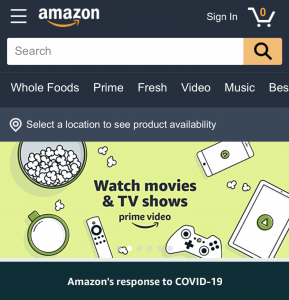Resources - Blog
How COVID-19 Is Impacting Amazon Consumer Spending

Stay on top of the latest e-commerce and marketplace trends.
As the COVID-19 crisis continues to progress, and self-quarantine and social distancing are put in place all across the U.S. and Europe, the overwhelming majority of customers are turning to e-commerce shopping for products that meet their current needs. This is because, as each day passes and the number of coronavirus cases continues to rise, many consumers are now avoiding even a quick trip to their local grocery store.
While in-store traffic in major retailers like Walmart and Costco has dropped, U.S. grocery e-commerce sales grew 25% for the period between March 13 and March 15 compared with the period between March 1 and March 11, according to Adobe data.
Amazon, in particular, has been experiencing an outstanding demand for household essentials like groceries, toilet paper, hand sanitizer, and more, and customers are willing to wait weeks to receive these items. Just as these items flew off the shelves at brick-and-mortar stores, they are selling out fast on Amazon, as well.
As a result of the boost in sales of such items, Amazon recently announced that it would hire an additional 100,000 workers in the U.S. to meet this spike in demand. However, it also announced that it would temporarily stop accepting all other inventory shipments at its FBA warehouses to make more space available for those products that are considered “essential items.”
What Counts as an “Essential” Product on Amazon?
The product categories that Amazon currently considers to be “essential” are Baby Products, Health and Household, Grocery, Beauty and Personal Care, Industrial and Scientific, and Pet Supplies.
In Amazon’s inventory update to sellers on March 27, the company did not list the specific types of products that have been expanded for FBA shipment creation. Sellers with active FBA product listings can visit the Restock Inventory page in their Seller Central account and will see a list of their products that are currently eligible for FBA shipments.
Sellers in these product categories are seeing a significant boost in sales. However, many are also struggling with supply chain delays and keeping items in stock, even though they are still able to send FBA inbound inventory shipments.
In fact, Amazon has updated its homepage to no longer feature products but rather content, such as music, movies, TV streaming, and books to reduce the influx of new orders for essential items causing delivery delays.

According to Marketplace Pulse, demand for essentials like toilet paper, hand sanitizers, paper towels, n95 face masks, and thermometers has not decreased since the end of February. However, those searches no longer have any results with Prime shipping or even any items in stock.
On the other hand, sellers of products in Toys and Games, Electronics, Books, and other categories are also seeing a sales surge based on the items customers are buying to entertain themselves while staying home. However, if these sellers are using FBA for their fulfillment, they are now facing additional challenges on having to find new distribution channels as stock runs low because these categories are not considered “essential.”
What Are the Current Category Sales Trends?
When taking a more in-depth look at how the COVID-19 crisis is impacting consumer spending trends on Amazon, the weekend of March 28-29, 2020, showed that the following types of products were listed on the top of different category’s Best Sellers list:
- Toys and Games: Chalk and markers
- Electronics: Fire TV sticks
- Camera and Photo: Binoculars
- Clothing, Shoes, and Jewelry: Sweatshirts and T-shirts
- Beauty and Personal Care: Hand sanitizer
- Health and Household: Toilet paper and disinfectant wipes
- Home and Kitchen: Bed sheets
- Industrial and Scientific: Disposable rubber gloves
- Office Products: Paper and printer ink cartridges
- Sports and Outdoors: Exercise resistance bands and yoga workout mats
- Tools and Home Improvement: Protective face masks
This snapshot of top-selling products shows that consumers are now spending their money on products that offer solutions to the current inconveniences they are facing during this crisis:
- Protection against COVID-19 (hand sanitizer, gloves, disinfectant wipes, face masks)
- Maximizing personal comfort (sweats and t-shirts, bed sheets)
- Upgrading home entertainment systems (Fire TV sticks)
- Being able to work and continue education from home (paper, ink cartridges, markers)
- Keep fit with at-home workouts (resistance bands and workout mats)
- Relieving boredom (binoculars)
How Can Amazon Sellers Can Benefit from These Consumer Buying Trends?
Governments and health organizations around the world still cannot say how long we will need to practice self-isolation. At best, it could be a few more weeks or, at worst, it could be a few more months. Yet, even when it becomes safe to leave our homes, people will likely continue with the more rigid sanitary practices they have been following, either out of habit or out of fear.
As Amazon sellers plan their business strategies for the coming months, they can look at these trends and adapt accordingly. For instance, if you are selling products that offer solutions to at home needs, then consider investing in larger inventory orders and partner with a third-party logistics (3PL) company to handle your storage, fulfillment, and shipping, if your products do not fall under Amazon’s “essential” list.
This is also the time to ramp up marketing efforts to bring awareness to your products, including running Amazon ads, creating video content, starting a brand community, and implement other strategies that will put your product in front of consumers.
If you are selling items that do not offer these at-home solutions, then you may want to postpone new product launches, and stop running ads and promotions. Instead, consider investing in expanding your product line with items that do meet these needs.
Final Thoughts
Amazon’s current sales trends look a lot different than they did just two months ago. In a few months from now, they could stay the same or they could go back to what they were before the COVID-19 pandemic. However, by then, consumer spending may be down overall due to a potential economic recession. At this point, nobody knows how it will all play out. Therefore, all businesses need to proceed with caution, but also be proactive on adapting your business strategies to the current trends we are seeing.
For more information on the coronavirus crisis and its impact on the Amazon marketplace, visit our COVID-19 resource center.
Learn what Feedvisor can do for your business.
When you partner with Feedvisor, you automatically receive access to our true, AI-driven technology and hands-on team of e-commerce experts. Contact one of our team members today to learn more about our end-to-end solution for brands and large sellers on Amazon, Walmart, and e-marketplaces.




